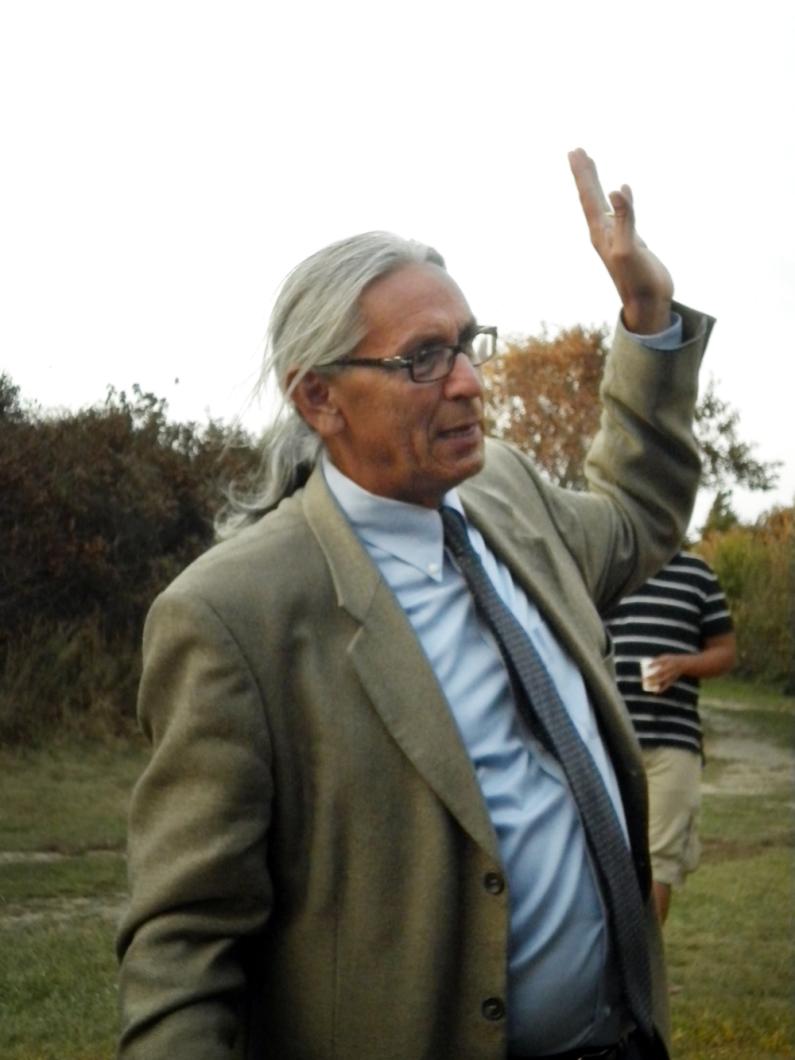Kevin Gover wants to set the record straight on the story of Pocahontas. It may come as a shock to a generation of children who grew up on beloved Disney movies, but the familiar story of the American Indian princess is largely falsified.
She may have had the colors of the wind float through her hair in the animated film version of the story, but in real life she did not save John Smith from execution by her father, the director of the National Museum of the American Indian told an attentive, packed house at the Aquinnah Cultural Center last weekend. Those were John Smith’s words, not hers, Mr. Gover said.
The museum hopes to set the record straight on this and other stories in new permanent exhibits in the coming years, Mr. Gover said in his talk. The audience included members of the Wampanoag Tribe of Gay Head (Aquinnah), Islanders and visitors.
Between 2014 and 2017, Mr. Gover said the museum will abandon its current format of 24 individual tribal exhibits and embrace a more national perspective. He said the new format will be a better fit with the mission of having a museum of, by and for American Indians but also be a teaching tool to all Americans. It will offer a deeper presentation of American history, he said.
“We want the visitors to accept all of this as American history . . . we want all Americans to feel a part of this history,” Mr. Gover said. “It is their inheritance as well. We want people to feel if they do not know of indigenous America then they don’t really know their American history.”
Other familiar stories the museum will explore in full exhibits include Thanksgiving and the Pilgrims, Little Big Horn, the Cherokee removal, and some stories that are less well known, such as King Philip’s War, the Pueblo revolt, genocide in California and the Black Seminoles.
The museum will include teepees in the new layout; Mr. Gover said previously there was reluctance to link teepees with American Indians, out of fear of stereotyping.
The former Assistant Secretary of the Interior for Indian Affairs took over the museum in 2007 following a storm of criticism around the museum, which among other things was accused of poorly handling American Indian history that either didn’t tell the real story or was too politically correct.
The museum is in the midst of a sea change in direction and mission, Mr. Gover said.
He said he hopes that stereotypes long associated with American Indians can be eliminated, especially if the stories come straight from the Indians themselves.
Interpretation has long been a problem for the indigenous people of the Americas, Mr. Gover said, one of the original reasons for establishing a national museum.
“The native story has always been presented by others. In popular culture, in formal education system, it’s not native people talking about themselves and explaining to the audience or students this is who we are, this is how we think, this is what we believe, it’s always other people doing that interpretation,” he said. “We speak not for ourselves but through anthropologists or historians or experts who know about these people.”
He said in film and literature, stories about American Indians are told in a non-Indian voice. He cited as examples The Last of the Mohicans by James Fenimore Cooper, Empire of the Summer Moon by S.C. Gwynne, and the coming remake of the Lone Ranger starring Johnny Depp as Tonto.
“They’re trying to make us magic, we can’t just be people we, can’t just be regular folks,” Mr. Gover said. “Indians get defined by others in the minds of most people and that’s why it was important there be a museum for Indians, by Indians, about Indians.”
He called on tribes across the country, including the Wampanoag Tribe of Gay Head (Aquinnah) to continue to preserve their own history because what is represented in Washington, D.C., is exactly that — a representation.
“The tribes are already doing a better job than we are . . . no matter what we do it can only be a replica of some sort,” he said. “It can be a very good replica but it’s still a replica, especially compared to what the tribes themselves are already doing in their own museums.”
Conscious of his role as speaker in a place that is home to the Wampanoags, he said: “This site doesn’t exist except in context, and to be here and see the ocean and see Noman’s Land over here, and know what’s on the other side . . . that provides the context you need.” He looked over the historic clay cliffs as the sun began to set and continued: “We can’t do all of that in Washington, D.C. So when I say the tribes are doing it better, I really mean it. We shouldn’t try to do what they’re already doing better than us.”




Comments
Comment policy »